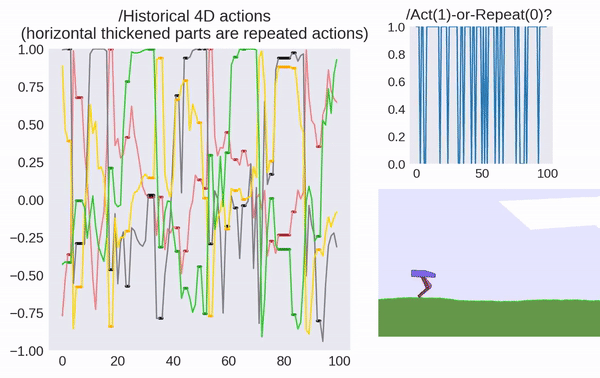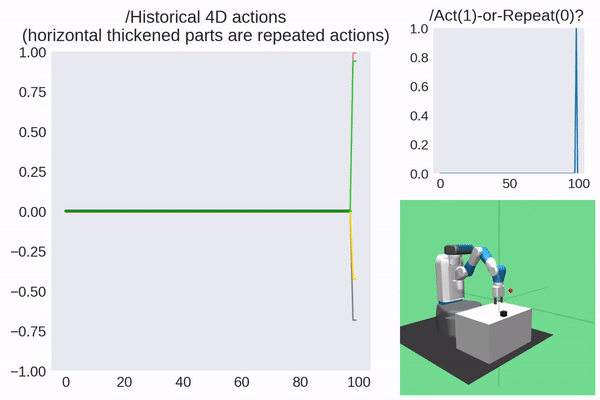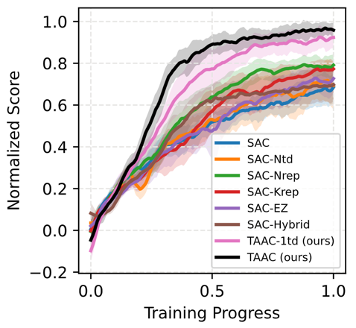This repo releases the code for
TAAC: Temporally Abstract Actor-Critic for Continuous Control, Yu et al., NeurIPS 2021.
It also contains the experiment configuration files for training TAAC on 5 categories of 14 continuous control tasks as done in the paper.
In a nutshell, TAAC is an off-policy (sample efficient!) actor-critic algorithm that has closed-loop action repetition (temporal abstraction!) built in.
- TAAC is in the middle ground between "flat" RL (e.g., SAC) and hierarchical RL (e.g., options, goals, etc).
- TAAC is conceputally simple. Its implementation closely resembles SAC.
- TAAC natively supports unbiased multi-step TD backup, with a novel compare-through operator!
TAAC largely outperformed several strong baselines on 14 complex continuous control tasks:
TAAC learns to skip learning to generate new actions at non-critical states, and save the actor network’s representational power for critical states!
More highlights can be found on this poster.
A detailed walkthrough of TAAC is in this video.
Our experiments use the training pipelines and algorithms of Agent Learning Framework (ALF). Python3.7+ is currently supported by ALF and Virtualenv is recommended for the installation. After activating a virtual env, download and install ALF:
git clone https://github.com/HorizonRobotics/alf
cd alf
git checkout fb30ce1 -B taac
pip install -e .On top of the basic ALF installation,
- One task category Terrain requires installing box2d-py.
- Two task categories (Manipulation and Locomotion) require installing Mujoco. Our experiments use Mujoco 2.0 and a different version might result in a different training result. So we suggest using this exact version for the reproduction purpose. Please follow the instructions at
https://github.com/openai/mujoco-py. - One task category Driving requires installing CARLA and we used version 0.9.9 in the experiments. Installation instructions can be found in
<ALF_ROOT>/alf/environments/suite_carla.py.
After the installation, clone this repo under ALF:
cd <ALF_ROOT>/alf/examples
git clone https://github.com/hnyu/taacTo run an experiment (e.g., training TAAC on BipedalWalker-v2):
cd <ALF_ROOT>/alf/examples
python -m alf.bin.train --root_dir=<TRAIN_JOB_DIR> --gin_file taac/experiments/taac/taac_terrain.gin --gin_param="create_environment.env_name='BipedalWalker-v2'"Then open the Tensorboard to view the training results
tensorboard --logdir=<TRAIN_JOB_DIR>The 14 tasks can be trained by providing the corresponding environment names to the 5 gin files
| gin file | create_environment.env_name |
|---|---|
<methdod>_simple_control.gin |
"MountainCarContinuous-v0" "LunarLanderContinuous-v2" "InvertedDoublePendulum-v2" |
<method>_locomotion.gin |
"Hopper-v2" "Ant-v2" "Walker2d-v2" "HalfCheetah-v2" |
<method>_terrain.gin |
"BipedalWalker-v2" "BipedalWalkerHardcore-v2" |
<method>_manipulation.gin |
"FetchReach-v1" "FetchPush-v1" "FetchSlide-v1" "FetchPickAndPlace-v1" |
<method>_driving.gin |
"Town01" |
The entire TAAC algorithm is implemented in the file alf/algorithms/taac_algorithm.py of the ALF repo downloaded.
- Sometimes running a job complains not finding rsync (ALF uses rsync to backup training code), you just need to first install it and try again. Or simply append the flag
--nostore_snapshotwhen launching the job. - CARLA "Fail to start server": just give it another try.
- If any error related to not finding
Python.hduring pip installing ALF, please first install the python development package, e.g.,sudo apt install python3.7-dev.
If you use TAAC in the research, please consider citing
@inproceedings{Yu2021TAAC,
author={Haonan Yu and Wei Xu and Haichao Zhang},
title={TAAC: Temporally Abstract Actor-Critic for Continuous Control},
booktitle={NeurIPS},
year={2021}
}




